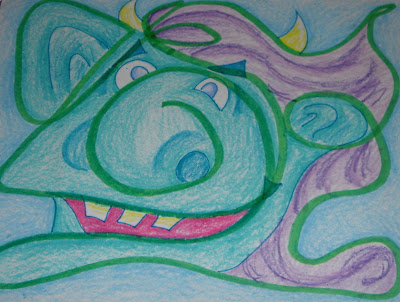
Project/Activity: Styrofoam Print
Age Level: Any--although a lot of adult help is advisable for K-3
Materials: Styrofoam (flat sheets, at least 4x6"), Smooth white paper (preferably not construction) washable printers' ink, brayer, pans for ink, mirrors.
Procedure:
1. Introduce the idea of creating a print. For younger students, show several examples of stamps. Ask the students to explain how using a stamp works. Explain that a print is a much larger version of a stamp. Specifically point out stamps of words. Why are the words backwards on the stamp? For older students, introduce the idea of a woodcut. Show examples of prints. Some great examples of classical woodcuts can be found at http://oldmasterprint.com. More child-accessible woodcuts can be found in the children's' books, Whaling Days by Carol Carrick and My Son John by Jim Aylesworth.
2. Using a very dull pencil and pressing very hard, have the students draw their image on the Styrofoam. Images will print backwards from the cut stamp. To ensure that students are drawing the opposite of what they really want to see, have mirrors available for them to check their work in.
3. Using the brayer, spread ink on the Styrofoam master.
4. Quickly press the master onto a piece of paper. Separate the master from the print. If desired, the master may be washed and used with a different colored ink.
5. Have a large flat area set aside for drying the prints. When the image has dried, have students complete their work by matting it or gluing it on a piece of colored paper.
Teaching tips:
Especially if the Styrofoam pieces are small, this activity goes very quickly. It is advisable to have more than one sheet for each student so that those who finish first will be able to work on another one.
Even older students need a lot of help understanding directionality and negative space. Which way will the print face? What parts will be dark or light when printed.
It is important to find inks that really are washable. For younger classes, have the adults do the actual stamping.
Below is an example of a sheet of Styrofoam incised with a design, ready for printing. At the top of the page is an example of a print made with a similar Styrofoam sheet.








